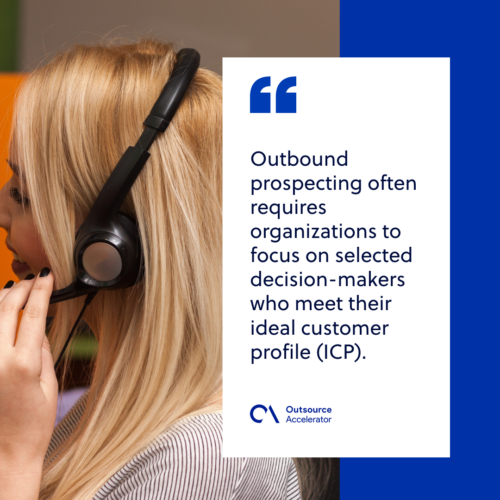Here’s how outbound prospecting sets your sales up for success

Sales prospecting is all about finding new clients, reaching out to them with a compelling proposal, and eventually encouraging them to buy.
Outbound prospecting is becoming increasingly challenging, with dozens, if not hundreds, of emails in daily inboxes. Capturing your prospects’ interest and making your subject line relevant is essential. Thus, doing these things will fill your sales pipeline.
What many thriving businesses do is adopt outbound prospecting techniques to keep their sales cycle moving.
In this article, we will discuss how outbound prospecting can help companies advance the sales success ladder.
Outbound prospecting defined
Outbound prospecting is a proactive sales strategy in which companies contact prospects who have not yet expressed interest.
It is the process by which sales representatives research, identify, and contact potential consumers to convert them.
Cold emailing and cold calling are the most common outreach methods for external prospecting. Contacting potential clients through LinkedIn or any other direct approach also falls under this category.
For example, B2B companies can expand their consumer base through outbound prospecting by fostering relationships with prospects.[1] Any business struggling to secure more transactions through cold prospecting can acquire better opportunities.

Generally, the outbound prospecting process covers the following:
- Determining your target consumers
- Contacting them personally
- Introducing yourself and your company’s products and services
- Checking to see whether you’re a good fit
Outbound prospecting objective
Outbound prospecting aims to find and attract prospective consumers to your sales funnel.[2] Executing outbound prospecting efforts can be challenging.
However, applying a proactive approach and reaching out to potential clients may generate leads that would not have come to you otherwise.
Key difference between inbound and outbound prospecting
Inbound prospecting is the process of recruiting leads who have already discovered your goods and services.
For instance, they may have already downloaded your ebook or liked your video advertisement. All you have to do is to keep them entertained and retain them.
Inbound prospecting includes content marketing, focused email marketing, and paid search advertising.
Outbound prospecting, on the other hand, is a more active approach in which salespeople actively seek out new consumers via:
- Cold emailing
- Cold calling
- Direct mailing
Although an inbound prospecting methodology has a better ROI, outbound prospecting may be beneficial when done appropriately.
5 tips for a successful sales outbound prospecting
Outbound prospecting often requires organizations to focus on selected decision-makers who meet their ideal customer profile (ICP). Once selected, salespeople will immediately begin the outreach process.
Here are five other essential tips for beginning your outbound prospecting journey and filling your sales funnel quickly:
1. Personalize your outreach
For your outreach efforts to be successful, you must first understand your prospects’ goals and requirements.
Research before picking up the phone, emailing, or sliding into a prospect’s DMs. Look for purchase signals and trigger events.
You may also ask the following questions to pattern your personalized outbound prospecting message:
- When was the last time you bought this item or service?
- What service provider are you currently using?
- How are things going with your present provider?
- When did you realize you had a changed business requirement?
- What additional service providers or solutions are you considering?
- What goods and services exactly are you seeing?
- What is the most crucial characteristic of a service provider?
- What are your key influencers saying about this issue?
2. Invest in high-quality data
In terms of research, the information you obtain about potential clients would be useless if it is erroneous and outdated.
Get and connect the most up-to-date corporate and customer information to your customer relationship management (CRM) platform. This way, you can be confident that you aren’t referring to obsolete news.
3. Explore new channels
Email outreach and cold calls will never go out of trend. But don’t limit your marketing teams to utilizing other methods of communication.
Leverage the power of social media to your advantage. Post the most recent material until your prospect can connect on other channels and make a buying decision.
4. Identify product pain points
Determinate particular business pain points that your goods and services can help solve. Customize your outreach to clearly describe the benefits of possible collaboration and how your solution may ease these pain points.
Remember that identifying difficulties does not imply telling prospects something is broken but describing how your services may provide answers.
5. Mention higher-ups for LinkedIn
On LinkedIn, it is always preferable to introduce a higher-up from the organization for outbound prospecting efforts. This will boost connections and engagements with industry professionals with someone with a similar title.

Effective outbound prospecting drives engagement and sales
Overall, effective outbound prospecting will help you gain the prospective consumer’s trust, get a chance to be recommended, and grow your customer base.
All you need to do? Follow these essential tips and build personal connections with customers and prospective clients starting today!
Article references:
[1] Fostering relationships with prospects: Anshari, M., Almunawar, M.N., Lim, S.A., Al-Mudimigh, A. (2019), “Customer relationship management and big data enabled: Personalization & customization of services.” ScienceDirect, Applied Computing and Informatics Journal, 2019, Vol. 15 (2), pp. 94-101. doi: https://doi.org/10.1016/j.aci.2018.05.004







 Independent
Independent




